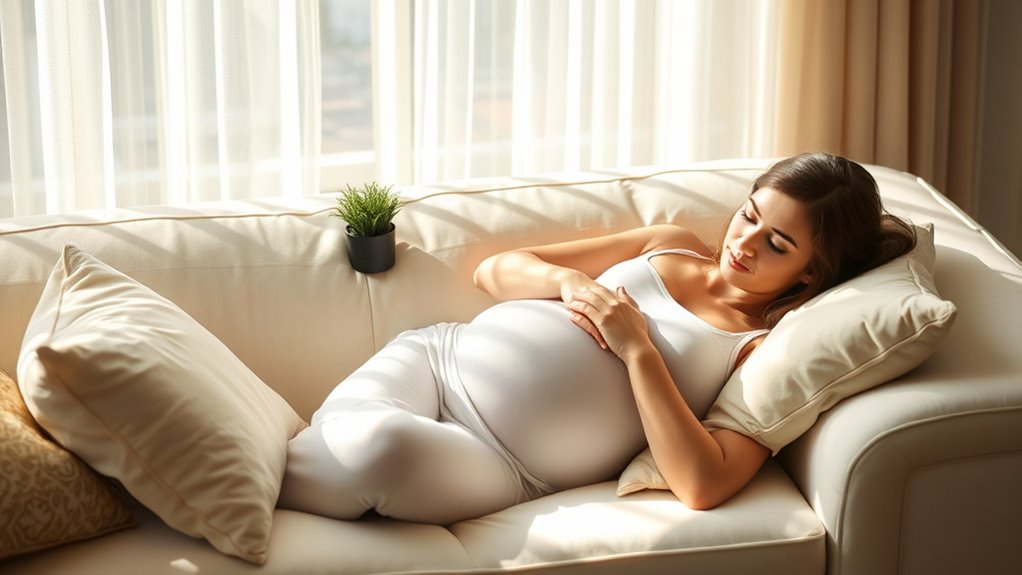Sleeping on your side, especially the left side, is essential during pregnancy. This position optimizes blood flow and nutrient delivery to your baby. Right side sleeping is also safe and offers comfort, but avoid back sleeping after 20 weeks due to potential risks from blood vessel compression. To enhance comfort, consider using pillows for support. There are effective strategies to manage pregnancy-related sleep disruptors. Discover more ways to guarantee a restful night ahead!
Key Takeaways
- The best sleeping position during pregnancy is side sleeping, particularly on the left side, for optimal blood flow to the uterus.
- Right side sleeping is also safe and can provide comfort with minimal risks compared to back sleeping.
- Avoid back sleeping after 20 weeks to prevent compression of major blood vessels, which can affect blood flow to the baby.
- Stomach sleeping becomes uncomfortable after 16 to 18 weeks due to abdominal growth and pressure, leading to potential discomfort.
- Using pillows for support can enhance comfort and alleviate pressure on hips and lower back while sleeping.
The Importance of Side Sleeping During Pregnancy

When you're pregnant, choosing the right sleeping position is essential for both your health and your baby's.
Side sleeping, especially on your left side, is highly recommended. This position optimizes blood flow to the uterus, ensuring your baby gets the nutrients they need while alleviating pressure on your liver and kidneys. Additionally, it can help reduce the risk of complications such as swelling in your extremities, which is common during pregnancy. Pregnant individuals should also be aware of filial responsibility laws, as these can impact long-term planning for family support. Furthermore, maintaining a healthy lifestyle that includes regular screenings can contribute to overall well-being during pregnancy. Understanding the importance of effective communication strategies during this time is also crucial for managing any stress that may arise.
While back sleeping is generally safe early in pregnancy, it can lead to complications after 28 weeks due to the risk of compressing major blood vessels.
Sticking to your left side not only enhances blood circulation but also helps reduce swelling in your extremities.
Using supportive pillows can make side sleeping more comfortable, making it easier to maintain this vital position throughout the night. Additionally, it's important to follow safe sleep guidelines to ensure both your and your baby's well-being during sleep.
Left Side Sleeping: Benefits for Mother and Baby

When you sleep on your left side during pregnancy, you boost blood flow, which benefits both you and your baby. This position not only helps reduce swelling and discomfort but also supports better nutrient delivery to your little one. Additionally, using essential oils for relaxation, such as lavender and chamomile, can enhance your sleep quality during this crucial time. Ensuring a balanced nutrient intake can further support your overall health and well-being during pregnancy. Furthermore, maintaining a proper budget for maternity expenses can alleviate financial stress during this important period. Engaging in adequate emotional regulation practices can also contribute to a more peaceful and restful pregnancy experience. It's essential to remember that proper sleep positions can significantly impact maternal health and promote optimal development for your baby.
Optimal Blood Flow Benefits
Sleeping on your left side during pregnancy offers significant benefits for both you and your baby by maximizing blood flow. This position enhances circulation from the inferior vena cava (IVC), reducing pressure on essential organs like the liver and kidneys, which improves their function.
Here's a quick overview of the benefits of left side sleeping:
| Benefit | For Mother | For Baby |
|---|---|---|
| Ideal Blood Flow | Improved circulation | Better nutrient delivery |
| Health Benefits | Enhanced organ function | Supporting fetal development |
| Reduced Pressure | Less strain | Promotes growth |
| Comfort | Alleviates discomfort | Stabilizes health |
| Recommended Position | Preferred by experts | Safe for development |
Reduced Swelling and Discomfort
Opting to sleep on your left side can greatly reduce swelling and discomfort during pregnancy.
Sleeping on the left optimizes blood flow by alleviating pressure on the inferior vena cava, enhancing circulation for both you and your baby. This position considerably reduces swelling in your hands, ankles, and feet, helping to relieve common pregnancy-related discomforts.
Additionally, left-side sleeping promotes better kidney function, which improves fluid balance and decreases edema. Research shows that this position also encourages better nutrient delivery to your baby, supporting healthy fetal development.
While both side sleeping positions are generally safe, sleeping on the left is specifically recommended for its added benefits in reducing maternal discomfort and promoting overall well-being during pregnancy.
Right Side Sleeping: Safety and Comfort

Finding a comfortable sleeping position during pregnancy can be challenging, but right side sleeping is generally considered a safe option. This position offers a good balance of comfort and safety, as it poses no significant health risks compared to left side sleeping.
While there's a slight risk of inferior vena cava (IVC) compression, it's not as pronounced as with back sleeping. You might find that short intervals of right side sleeping enhance your comfort while still allowing adequate blood flow to the fetus.
To maximize comfort, consider rotating your sleeping positions, including the right side, throughout the night. This variation can help reduce pressure on specific areas of your body, promoting a more restful sleep.
Risks of Back Sleeping in Later Trimesters

As your pregnancy progresses into the later trimesters, back sleeping poses significant risks that you should be aware of. Research indicates that sleeping on your back in the third trimester can increase the risk of stillbirth. The weight of the uterus may compress major blood vessels, restricting blood flow and oxygen to your baby. This supine position can adversely affect fetal activity and heart-rate patterns, which raises concerns for fetal well-being. If you wake up on your back, it's advised to return to a side-sleeping position.
| Risk Factor | Effect on Pregnancy | Recommended Position |
|---|---|---|
| Sleeping on your back | Increased risk of stillbirth | Side-sleeping position |
| Restricted blood flow | Adverse fetal heart patterns | Side-sleeping position |
| Uterus weight | Potential fetal distress | Side-sleeping position |
Getting Comfortable: Tips for Side Sleeping

While shifting to side sleeping during pregnancy can feel challenging, there are effective strategies to enhance your comfort.
Start by placing a pillow between your legs; this helps relieve pressure on your hips and lower back while sleeping on your side. You might also consider using a pregnancy pillow for full-body support that maintains a cozy side position.
Positioning additional pillows behind your back can prevent you from rolling onto your back during the night. To further elevate your upper body, prop yourself up with extra pillows, which can ease heartburn and shortness of breath.
Don't hesitate to experiment with different side positions, as rotating sides throughout the night can greatly improve your comfort and sleep quality.
Sleep Positions to Avoid for Health Reasons

When you're pregnant, certain sleep positions can pose health risks for both you and your baby.
Sleeping on your back, especially in the third trimester, can lead to complications like decreased circulation and increased chances of stillbirth.
As your belly grows, stomach sleeping becomes uncomfortable and impractical, making side sleeping the best option for a restful night.
Risks of Back Sleeping
Sleeping on your back during pregnancy can pose significant risks, especially in the third trimester.
Research shows that this position increases the risks of stillbirth, primarily due to the compression of major blood vessels that restricts blood flow and oxygen delivery to your baby. This lack of sufficient oxygen can adversely affect fetal well-being, altering heart-rate patterns and reducing fetal activity.
Experts recommend avoiding back sleeping after 20 weeks to mitigate these risks, as you may also experience discomfort and dizziness.
If you find yourself waking up on your back, it's essential to shift to a side position, since your initial sleep position is usually maintained the longest.
Prioritize your baby's health by sleeping on your side.
Stomach Sleeping Discomfort
As your pregnancy progresses, you may find stomach sleeping increasingly uncomfortable and impractical. In the early stages, it might feel okay, but after 16 to 18 weeks, the growing abdomen can cause significant discomfort.
The pressure on your belly and tender breasts can make this position less desirable. Continuing to sleep on your stomach could compress your baby and major blood vessels, leading to possible complications with blood circulation and oxygen supply.
Additionally, the growing belly can contribute to back pain and digestive issues. To promote better comfort and health, consider switching to side sleeping. This position not only alleviates discomfort but also supports your body as it adapts to the changes of pregnancy.
Managing Discomfort: Common Sleep Disruptors

Managing discomfort during pregnancy often involves addressing common sleep disruptors that can impact your rest.
Frequent nighttime bathroom trips can interrupt your sleep due to hormonal changes that increase kidney function.
Heartburn, another culprit, arises from hormonal influences and pressure from your growing uterus, leading to discomfort and restlessness.
As your pregnancy progresses, shortness of breath may make it challenging to find a comfortable position.
You might also experience leg cramps from changes in circulation and muscle fatigue, further disrupting your sleep patterns.
Insomnia can creep in as hormonal fluctuations and anxiety about childbirth affect your overall sleep quality.
Recognizing these disruptors is key to improving your sleep and managing discomfort during this important time.
Creating a Sleep-Friendly Environment

Creating a sleep-friendly environment is essential for ensuring you get the rest you need during pregnancy. Aim for a dark, quiet, and cool space to promote quality sleep.
Invest in blackout curtains to block out light, helping your body regulate its sleep-wake cycle. A comfortable temperature between 60-67°F (15-19°C) is ideal for restful nights.
Consider using a white noise machine or fan to mask disruptive sounds, creating a calming atmosphere. Keep your bedroom clutter-free and organized to reduce stress and make it easier to unwind.
Finally, choose comfortable bedding, with a supportive mattress and soft sheets, to enhance your overall comfort and alleviate pregnancy-related discomfort.
Prioritize your sleep-friendly environment for better rest and relaxation.
The Role of Pillows in Improving Sleep Quality

When it comes to improving sleep quality during pregnancy, the right pillows can make all the difference.
Using a pillow between your legs can relieve hip and lower back discomfort, promoting better alignment during side sleeping.
Pregnancy pillows, especially U or C shapes, provide extensive support for your growing belly, enhancing overall comfort.
Wedge pillows can help maintain your side sleeping position and prevent rolling onto your back after the 20-week mark.
Elevating your upper body with pillows can also alleviate heartburn, a common sleep disruptor.
Don't hesitate to experiment with different pillow arrangements to find what works best for you, allowing for rotation throughout the night to maximize your restfulness.
Seeking Professional Advice for Sleep Issues During Pregnancy

If you're struggling with sleep issues during pregnancy, consulting your healthcare provider can help you find personalized solutions.
They can assess your symptoms and suggest safe practices, including proper sleep positions.
Don't hesitate to seek professional advice, especially if you're facing persistent challenges or discomfort.
Consulting Healthcare Providers
Consulting healthcare providers is essential for addressing sleep issues during pregnancy, as they can tailor advice to your specific health needs.
They'll help you navigate the complexities of safe sleep positions, especially after 28 weeks, when back sleeping poses increased stillbirth risks. Regular check-ins can effectively monitor pregnancy-related discomforts like insomnia and back pain.
Here are three ways they can assist you:
- Recommend safe sleep positions to enhance comfort and reduce risks.
- Provide personalized sleep hygiene practices to improve sleep quality.
- Address any pre-existing conditions that may impact your maternal and fetal well-being.
Sleep Disorder Resources
Many expectant mothers face sleep disorders during pregnancy, which can impact both their well-being and that of their baby.
It's essential to consult healthcare providers if you're experiencing symptoms like insomnia or restless legs syndrome. They can assess your sleep quality and help you understand how these sleep disorders may affect your maternal health and pregnancy progression.
Regular screenings can identify any potential issues, allowing for timely intervention. While some sleep aids may be available, always discuss their safety with your healthcare professional first.
Additionally, seek out educational resources and studies to gain insights into managing sleep issues effectively. Prioritizing your sleep won't only enhance your health but also contribute positively to your baby's development.
Frequently Asked Questions
What Position Should I Lie Down During Pregnancy?
When you're pregnant, it's best to lie on your left side with your knees bent.
This position helps optimize blood flow to your baby and reduces swelling in your legs.
While you can also sleep on your right side, the left side is preferred.
Avoid sleeping on your back after 20 weeks to prevent discomfort and complications.
Use pillows for support to keep you comfortable and relieve any pressure on your body.
What Are 5 Warning Signs of a Possible Problem During Pregnancy?
During pregnancy, you should watch for warning signs that could indicate a problem. If you experience severe abdominal pain and bleeding, seek immediate help.
Sudden swelling in your hands, feet, or face, along with severe headaches, could signal preeclampsia. Persistent vomiting that prevents you from keeping food down might mean hyperemesis gravidarum.
Reduced fetal movement after 28 weeks is concerning. Finally, fever or unusual discharge could suggest an infection that needs prompt attention.
What Positions Can You Lie in When Pregnant?
When you're pregnant, you'll find that sleeping positions matter more than ever.
You should try lying on your left side with your knees bent; it boosts blood flow and reduces swelling. The right side's okay too, but it carries a slight risk of IVC compression.
Avoid sleeping on your back after 28 weeks, as it can restrict blood flow to your baby.
As for stomach sleeping, it's comfy until around 16 weeks.
At What Point in Pregnancy Should You Stop Lying on Your Back?
You should stop lying on your back after about 20 weeks of pregnancy.
At this stage, your growing belly can put pressure on major blood vessels, reducing blood flow and oxygen to your baby. This can lead to discomfort and potential complications.
If you find yourself waking up on your back, gently roll onto your side for better safety and comfort.
Your body will usually guide you toward the most comfortable position as you progress.
Conclusion
In summary, finding the right sleeping position during pregnancy is essential for both you and your baby. Think of side sleeping as a cozy, protective cocoon that nurtures your growing little one. While the left side offers the most benefits, don't shy away from the right side if it feels more comfortable. By prioritizing your rest, you'll rise each day feeling more refreshed and ready to embrace the beautiful journey of motherhood ahead. Sleep well!








